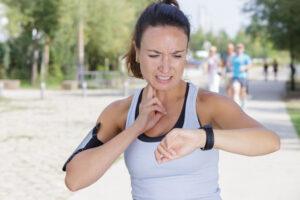
When you exercise, your body pumps more oxygen to your muscles. To accomplish this, your heart rate must increase the resistance to blood flow in your vessels must drop. A normal heartbeat at rest is between 60 and 100 times per minute; however, during an intense workout, the rate can more than double.
After completing working out, your heart rate gradually drops. This is because your heart and muscles no longer need to work as hard as oxygen demands slowly drop. What you might not realize is a heart rate that slows faster after a workout may be a measurable marker of heart health.
What if Your Heart Rate Recovery is Slow?
Now that you know why your heart speeds up, how does it do so? It gets help from key hormones, particularly two called epinephrine or norepinephrine, the so-called “fight or flight” hormones. When levels of these key hormones rise, your heart beats faster, your blood pressure increases, and blood flow to your muscles surge.
How quickly your heart muscle recovers to a more “relaxed” state after a workout is a marker of cardiovascular health. If you have good cardiovascular fitness, your heart rate will drop faster once your workout ends than someone with poor cardiovascular fitness or an unhealthy heart.
If your heart recovers slowly after a workout, you have a slow recovery heart rate. Why does this matter? Studies show a slow recovery heart rate is associated with a greater risk of cardiovascular death and a higher risk of other health problems, including metabolic syndrome, a precursor to type 2 diabetes and cardiovascular disease.
According to a study published in the New England Journal of Medicine, your heart rate should drop at least 12 beats within the first minute after exercise. If it falls more slowly and the drop is less than 12 beats after resting for one minute, heart rate recovery is slow, and studies link a slow recovery heart rate with a higher risk of death.
How to Measure Heart Rate Recovery
There’s a simple way to measure your heart rate recovery at home and some fitness centers use this technique All you’ll need is a step or platform about 12 inches high to step on to. Here’s how to measure your recovery heart rate:
- Step up and down off the box or platform for 3 minutes. Keep the pace brisk.
- At the end of 3 minutes, count your pulse rate at your neck for 15 seconds and multiply the value by 4 to get your heart rate per minute.
- Stop exercising and stand still for 1 minute. Then recheck your pulse rate again in the same manner.
- Subtract the two values to get your heart rate recovery.
Is less than 12, it’s a warning that you may be at greater risk for cardiovascular mortality. If your heart rate recovery is slow, let your doctor know, but you can improve your heart rate recovery over time through cardiovascular exercise.
Some factors can give you a falsely low reading. One example is not sleeping well the night before. Also, having a fever, drinking alcohol, smoking, or being dehydrated can cause a falsely slow recovery heart rate. Certain medications and health problems, such as an overactive thyroid can also affect recovery heart rate.
If your heart rate drops 20 beats or more after one minute, you have a fast heart rate recovery and a low risk of cardiovascular death. That’s good news! Most people fall in the mid-range, around 15 to 17. If you have a slow heart rate recovery, mention it to your doctor and then work on improving the health of your heart. Recheck it again 3 to 6 months after the first one to see whether it’s improved. As you get more physically fit, your heart rate recovery should improve, and your heart rate will drop faster after a workout.
The Bottom Line
Heart rate recovery is a simple test you can do at home that provides information about how heart health and physical fitness. It doesn’t replace the need to see your doctor regularly and monitor other markers of heart health such as blood pressure, blood sugar, and lipids. Keep doing those things too!
References:
Merck Manual. 18th edition.
N Engl J Med 1999; 341:1351-1357, DOI: 10.1056/NEJM199910283411804.
VeryWellFit.com. “How to Use Recovery Heart Rate for Fitness and Health”
Journal of the American Heart Association. May 5, 2017. Vol 6, Issue 5.
Exp Physiol. 2010; 95:431-440.
Journal of the American Heart Association. February 18, 2020. Vol 9, Issue 4.
J Korean Med Sci. 2006 Aug; 21(4): 621-626.
